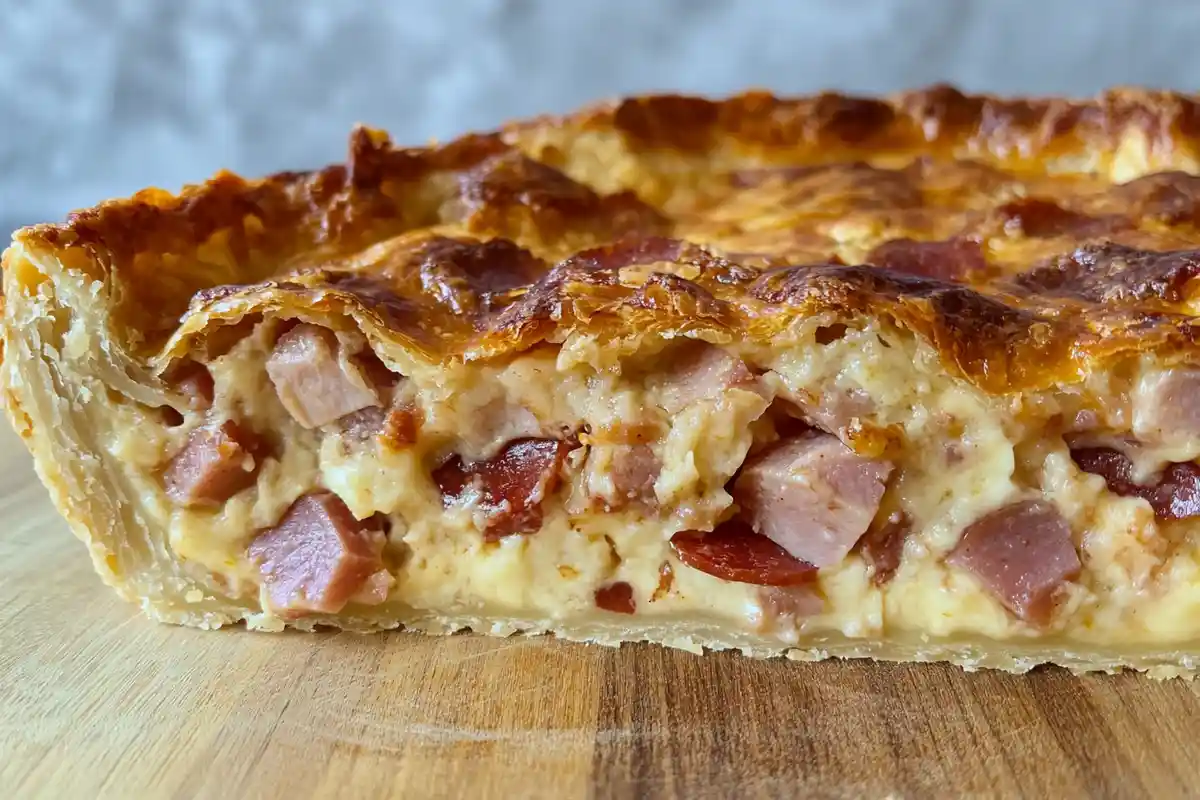With its vibrant culinary heritage, Italy offers countless delights, but few are as celebrated during Easter as the iconic Italian Easter Pie. This savory treat, brimming with layers of rich cheeses, cured meats, and aromatic herbs, has graced Italian tables for centuries. Often referred to as Pizzagaina in dialect, the pie symbolizes not just a meal, but a celebration of abundance and joy, perfect for festive gatherings and eagerly anticipated during Easter.
This article delves into this beloved dish’s origins, preparation, and traditions. From its historical roots to the secrets of crafting the perfect crust, you’ll uncover everything you need to know about this Easter classic.
If you’re interested in learning about Italian dishes, why not explore more delightful recipes to elevate your culinary adventures? At Ziarecipes, we have a variety of dishes that pair beautifully with or offer creative inspiration for your Easter and other festive meals. Check out these related recipes:
- Sourdough Dinner Rolls: Perfectly soft and fluffy rolls that are a fantastic accompaniment to any savory pie.
- Spinach Ravioli Recipe: A fresh and flavorful pasta dish that complements traditional Italian feasts.
- Creamy Parmesan Italian Sausage Soup: A comforting bowl of soup to start any meal with a burst of flavor.
- Sourdough Discard Pizza Dough: Learn how to create a perfect pizza base with sourdough discard—an excellent choice for family gatherings.
Table of Contents
Understanding Italian Easter Pie
What Is Italian Easter Pie?
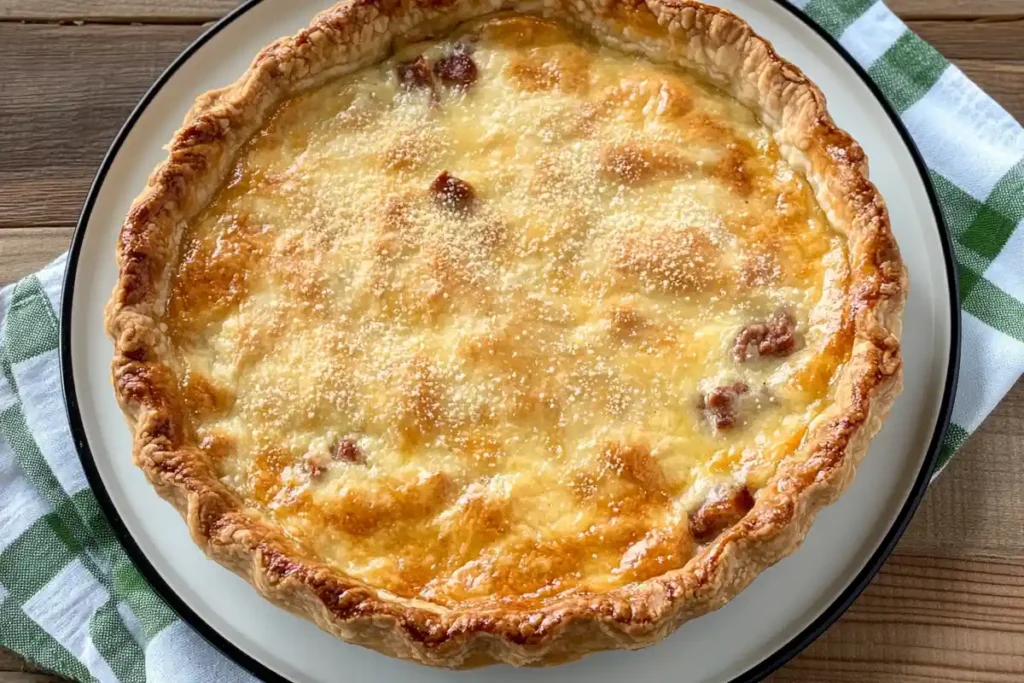
The Italian Easter Pie, or Pizzagaina, is a savory masterpiece baked during Easter, particularly on Holy Saturday. It is encased in a flaky crust and holds an indulgent medley of cured meats, eggs, and cheeses. This culinary tradition not only celebrates Easter but also marks the end of Lent—a period of fasting in which such rich ingredients were avoided.
Families come together to enjoy the pie warm, its aroma filling kitchens with memories of generations past. Whether you’re in Naples, Sicily, or Calabria, variations of this dish abound, each reflecting regional flavors and customs.
Historical Origins of Italian Easter Pie
The origins of the Italian Easter Pie are as layered as its filling. Many believe it dates back to ancient Rome, where early recipes featured dough stuffed with meats and cheeses. Over time, it evolved into a symbol of Easter, embodying themes of rebirth and renewal. This rich history connects us to the culinary traditions of our ancestors, making each bite a journey through time.
In medieval Italy, these pies were often offered to clergy during Easter celebrations. As trade flourished, new ingredients like prosciutto and mozzarella enriched the dish, creating the version we relish today.
Regional Variations
While Pizzagaina is most closely associated with Southern Italy, nearly every region boasts its rendition. In Naples, for instance, the filling is heavily ricotta and egg-based, while Liguria’s Torta Pasqualina incorporates greens like spinach or chard. These regional variations showcase the diversity and richness of Italian cuisine, ensuring every bite tells a unique story tied to its roots.
Northern versions may include unique local cheeses, while some families even adapt their recipes with modern twists, incorporating gluten-free crusts or plant-based ingredients. The diversity ensures every bite tells a story tied to its roots
Ingredients and Preparation
Key Ingredients in Italian Easter Pie
Crafting the perfect Italian Easter Pie begins with choosing the right ingredients. This dish thrives on its simplicity, but the quality of its components can elevate it from good to unforgettable.
Traditional Fillings
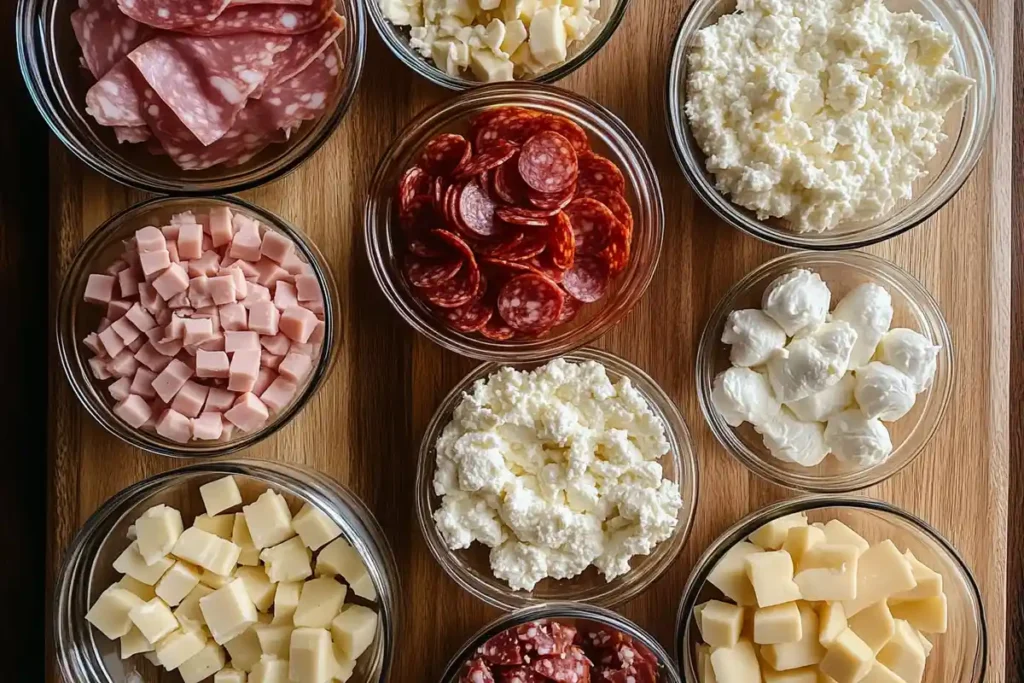
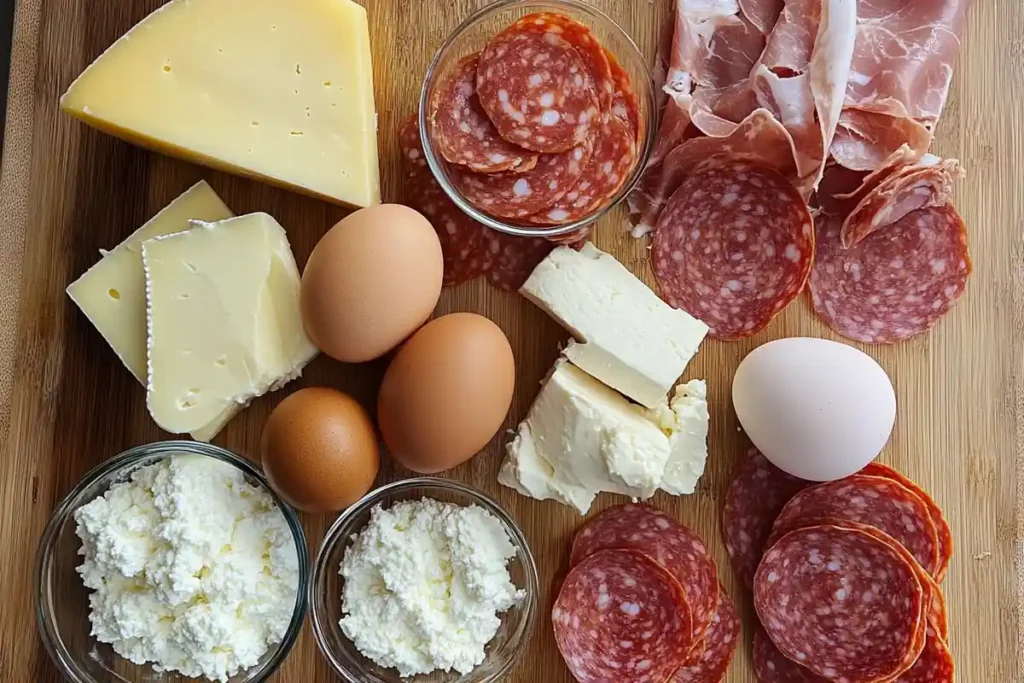
The heart of the pie lies in its savory filling, a decadent mix of cured meats and creamy cheeses. Classic options include:
- Cured Meats: Salami, prosciutto, capicola, and pepperoni bring layers of flavor, combining salty, smoky, and savory notes.
- Cheeses: Ricotta forms the base of the filling, often paired with mozzarella for its stretchiness and Parmesan or Pecorino for sharpness.
- Eggs: Acting as a binding agent, eggs create a custard-like texture that holds the filling together.
Dough and Crust
The crust of Italian Easter Pie is as essential as its filling. A rich, buttery dough is traditionally prepared, offering a flaky, golden casing. Some modern versions use puff pastry for added lightness.
Flavor Enhancements
Herbs like parsley, oregano, and basil infuse the pie with fresh, earthy aromas. A sprinkle of cracked black pepper or a dash of nutmeg can deepen the flavor profile, creating a harmonious balance between the robust meats and creamy cheeses.
Step-by-Step Preparation Guide
Making Italian Easter Pie is a labor of love, but the result is worth the effort. Here’s how to do it:
Preparing the Dough
You’ll need flour, butter, eggs, and a pinch of salt to achieve a flaky, tender crust. Combine the dry ingredients in a large bowl, cutting the butter into the flour until it resembles coarse crumbs. Add beaten eggs and a touch of cold water, kneading gently until the dough forms. Let it rest in the refrigerator for at least 30 minutes to enhance its texture.
Making the Filling
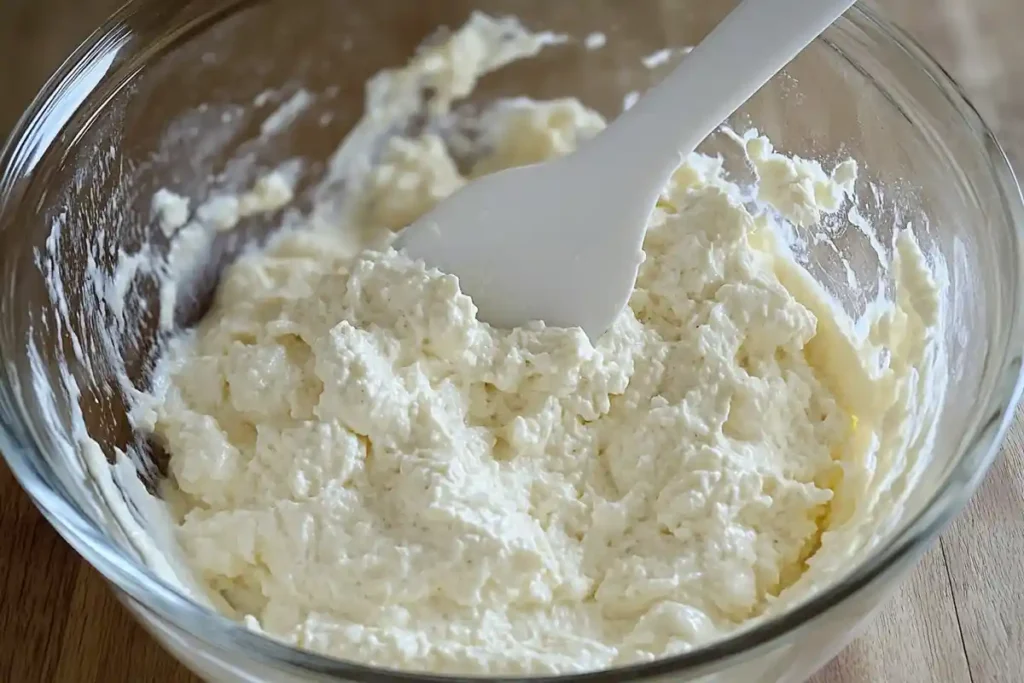
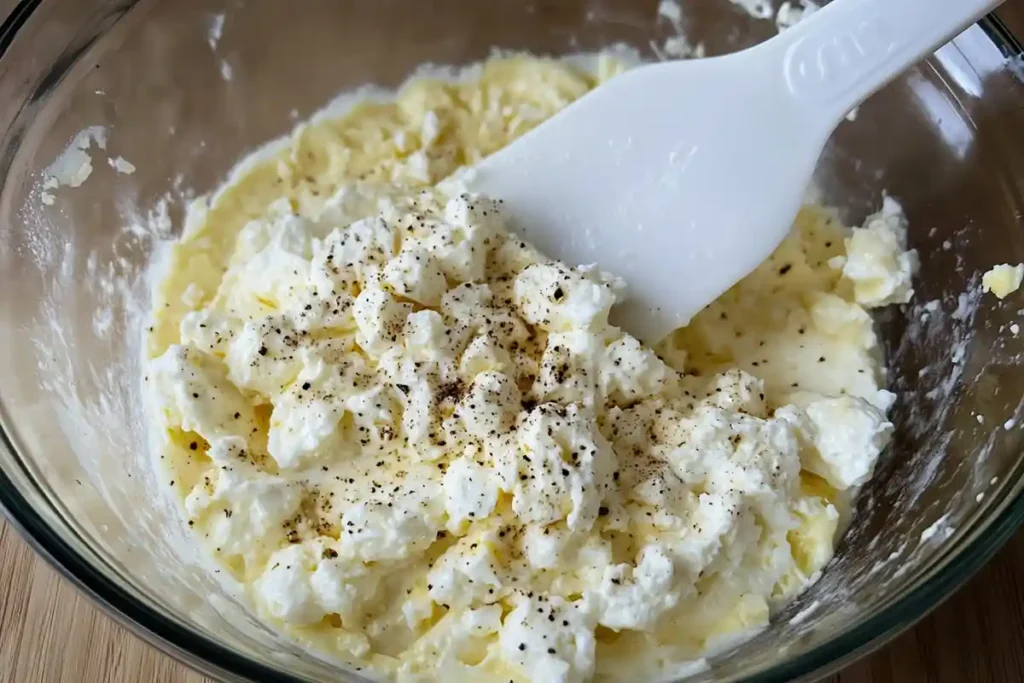
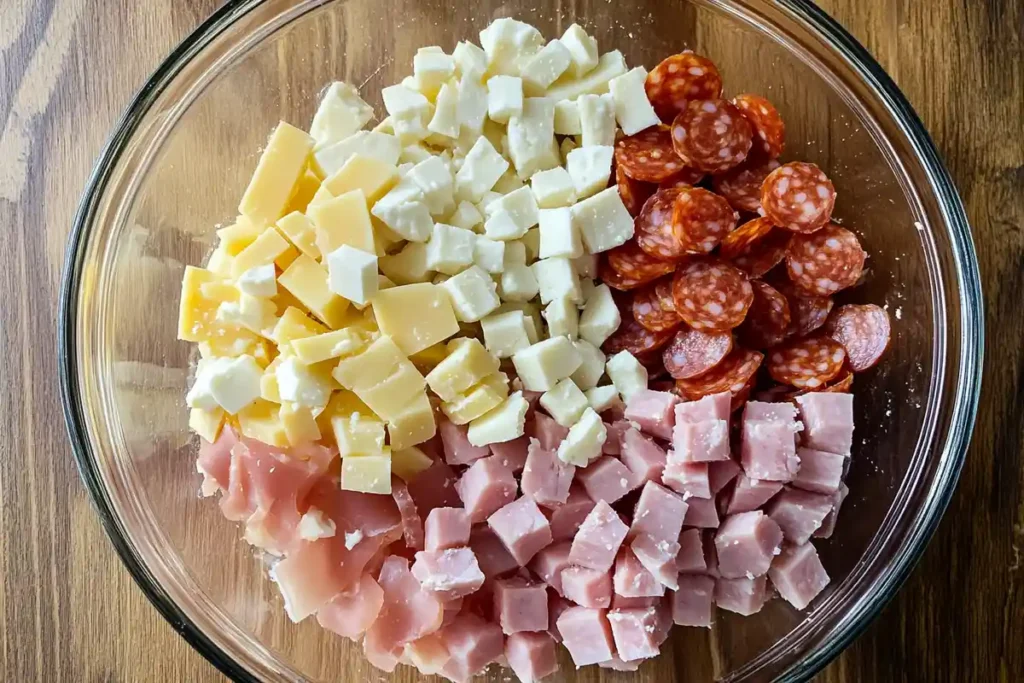
Start by dicing your meats and cheeses into bite-sized pieces. Mix ricotta with beaten eggs, Parmesan, and seasonings in a separate bowl until smooth. Fold in the chopped ingredients, ensuring an even distribution. The filling should be rich but not overly wet.
Assembling the Pie
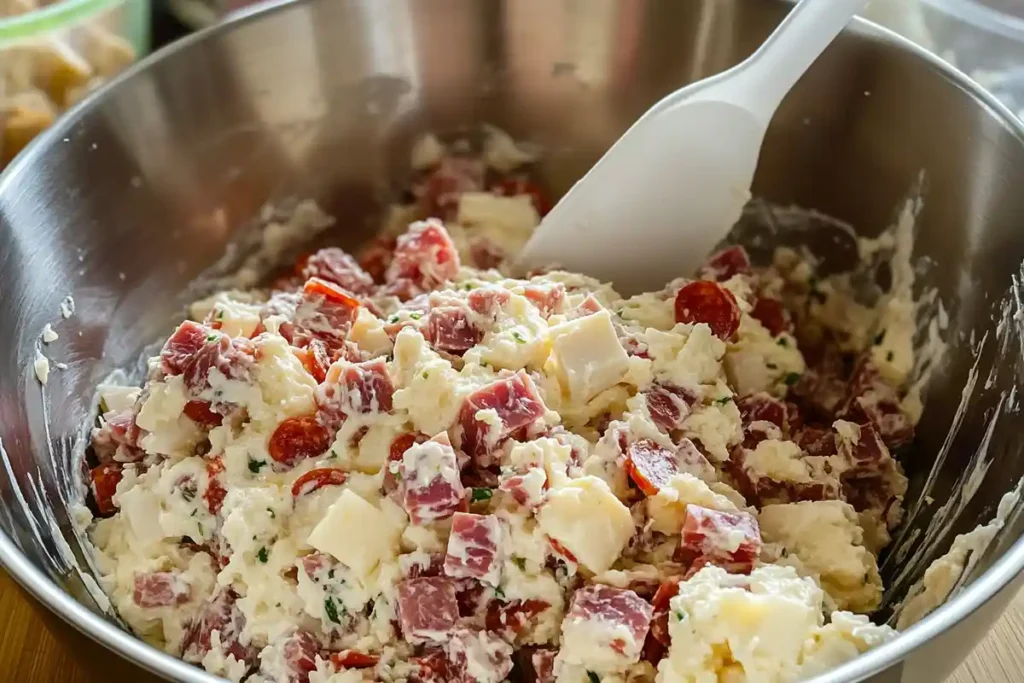
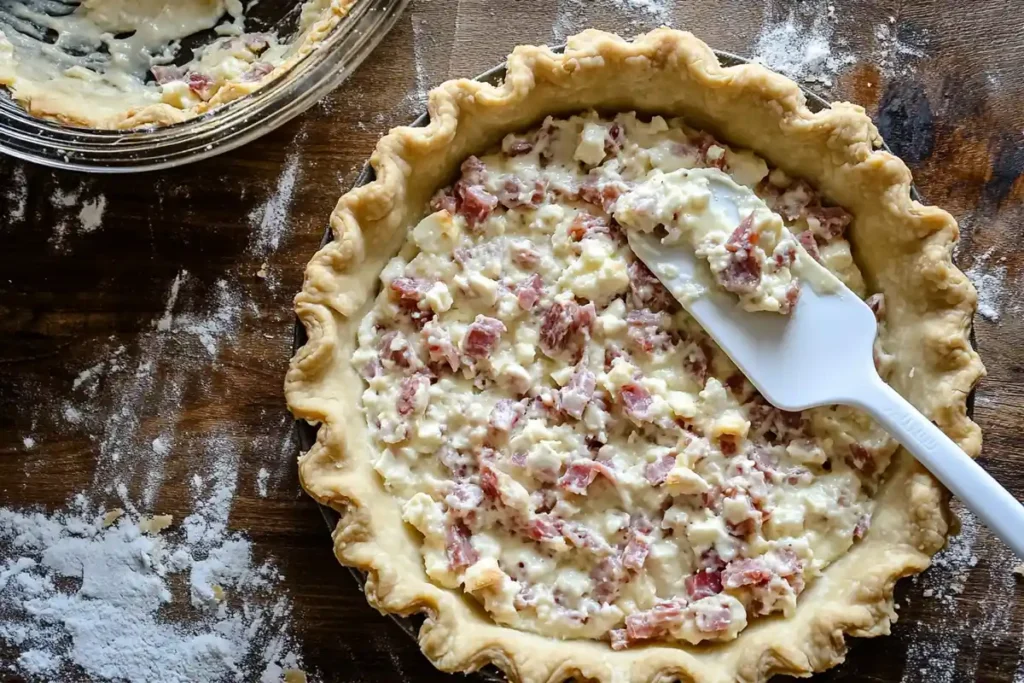
Roll out your chilled dough, lining a greased pie dish with the bottom crust. Spoon in the filling, spreading it evenly. Roll out another layer of dough for the top crust, sealing the edges carefully. For a decorative touch, crimp the edges or use leftover dough to create designs. Remember to cut a few slits in the top to allow steam to escape.
Baking Tips
Preheat your oven to 375°F (190°C). Brush the top crust with an egg wash for a glossy finish, and bake the pie for 50–60 minutes, or until the crust is golden brown. Allow it to cool slightly before slicing, as this helps the filling set.
Serving and Pairing Italian Easter Pie
How to Serve Italian Easter Pie
Once your Italian Easter Pie is baked to perfection, serving it thoughtfully can enhance the overall experience. This dish isn’t just about taste—it’s about creating a moment that captures the warmth of Italian hospitality.
Ideal Serving Temperatures
Traditionally, Italian Easter Pie is served either warm or at room temperature. Serving it warm allows the flavors of the meats and cheeses to shine, as the filling becomes creamy and aromatic. The flavors meld together more subtly at room temperature, making it equally enjoyable. Whichever you choose, the pie should never be served straight from the oven, as cooling slightly allows the filling to firm up for cleaner slices.
Accompaniments
Pairing the pie with complementary dishes can turn it into a feast:
- Salads: A simple arugula salad with lemon vinaigrette provides a refreshing contrast to the richness of the pie.
- Vegetables: Roasted asparagus, sautéed spinach, or grilled artichokes add a seasonal touch.
- Beverages: Serve with a crisp white wine, like Pinot Grigio, or a light red, such as Chianti. Non-alcoholic options like sparkling water with lemon also work beautifully.
Storing and Reheating Leftovers
One of the best things about Italian Easter Pie is how well it keeps, making it a delight to enjoy for days after Easter.
Proper Storage Methods

Once the pie has completely cooled, wrap it tightly in plastic or aluminum foil. Refrigerate for up to five days. Cut it into individual slices for extended storage, wrap each slice separately, and freeze for up to three months.
Reheating Instructions
Reheating the pie properly ensures that the crust stays flaky and the filling retains its creamy texture:
- Oven Method: Preheat your oven to 350°F (175°C), place the pie (or a slice) on a baking sheet, and cover loosely with aluminum foil. Heat for about 15–20 minutes or until warmed through.
- Microwave Method: For quick reheating, use a microwave at medium power for 1–2 minutes. While this method is faster, it may slightly soften the crust.
Cultural Significance and Traditions
Italian Easter Celebrations
Easter in Italy, or Pasqua, is a religious observance and a time to celebrate family, community, and the joys of spring. Food plays a central role in these festivities, and few dishes are as symbolic as the Italian Easter Pie.
Role of the Easter Pie in Festivities
The Italian Easter Pie graces tables on Holy Saturday and Easter Sunday as a centerpiece of the celebration. Its rich ingredients symbolize abundance, a joyful contrast to the simpler meals often eaten during Lent. Preparing the pie is a family affair, bringing generations together to honor tradition.
Families often begin their Easter meal with the pie, sharing stories and laughter as they savor its layers of flavor. Slicing into the pie feels almost ceremonial, a shared moment of gratitude and festivity.
Family Traditions and Recipes
In many Italian households, recipes for Italian Easter Pie are closely guarded treasures passed down through generations. Each family has its unique twist—whether it’s a special cheese, a specific blend of meats, or even a secret spice.
Pie-making often begins days before Easter, with family members gathering to prepare the dough, chop ingredients, and assemble the filling. This ritual fosters a sense of togetherness and keeps cultural traditions alive.
Similar Traditional Italian Easter Foods
Italy’s rich culinary landscape offers other delightful dishes enjoyed during Easter. Each region boasts unique creations, showcasing the country’s diverse flavors and customs.
Pastiera Napoletana
This sweet ricotta and wheat pie hails from Naples and is infused with citrus flavors, orange blossom water, and cinnamon. A favorite alongside the Italian Easter Pie, it represents rebirth and renewal.
Torta Pasqualina
Originating from Liguria, this savory pie features a flaky crust filled with greens like spinach or Swiss chard, ricotta, and whole eggs baked inside. It’s a symbol of springtime fertility and life.
Casatiello
A savory bread from Naples, Casatiello is filled with salami, cheese, and black pepper. Often shaped into a ring and decorated with whole eggs, it’s a visual and flavorful highlight of Easter feasts.
Frequently Asked Questions (FAQs)
What is some traditional Italian Easter food?
Italy’s Easter feast celebrates its diverse culinary heritage, featuring dishes that symbolize renewal and abundance. In addition to Italian Easter Pie (or Pizzagaina), popular choices include:
- Pastiera Napoletana: A sweet, citrus-infused ricotta and wheat pie from Naples.
- Torta Pasqualina: A savory pie from Liguria with greens, eggs, and ricotta.
- Colomba Pasquale: A dove-shaped cake symbolizing peace and the Holy Spirit.
- Casatiello: A Neapolitan savory bread filled with meats and cheeses.
How do you pronounce Pizzagaina?
The term Pizzagaina—a dialectal variation of pizza chiena (meaning “full pie”)—is pronounced as:
peet-zah-gai-nah
This name perfectly captures the pie’s essence, as it’s brimming with a generous mix of meats, cheeses, and eggs.
Why is it called Easter pie?
The Italian Easter Pie is closely tied to the Easter celebration as it marks the end of Lent, a period of fasting and abstinence. The indulgent ingredients, including cured meats, eggs, and cheeses, were traditionally reserved for feasts following Lent.
The pie is more than just food—it symbolizes joy, abundance, and renewal. Its preparation and sharing during Easter gatherings embody the spirit of the season.
What is the shape of the Italian Easter cake?
The Colomba Pasquale, Italy’s iconic Easter cake, is shaped like a dove (colomba means “dove” in Italian). This shape represents peace, the Holy Spirit, and the essence of Easter. The cake, made with a soft, sweet dough, is topped with sugar and almonds, offering a delightful contrast to the savory Italian Easter Pie.
Conclusion
The Italian Easter Pie is more than just a dish; it symbolizes celebration, family, and tradition. With its rich blend of cured meats, creamy cheeses, and flaky crust, the pie encapsulates the joy and abundance of Easter in every bite. Its preparation brings families together, honoring centuries of cultural heritage passed down through generations.
From its historical roots to its role in modern-day festivities, the Italian Easter Pie remains cherished on tables across Italy and beyond. Whether savoring it warm on Easter morning or enjoying leftovers days later, this dish carries the warmth of Italian hospitality and the spirit of renewal.
As you create your own Italian Easter Pie, remember that every fold of the dough and every layer of filling connects you to a time-honored tradition. Buona Pasqua—Happy Easter—and may this delicious pie bring joy to your holiday celebrations!

